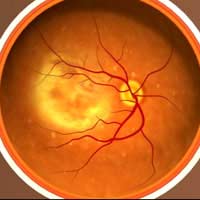Treating Age Related Macular Degeneration

Age-related macular degeneration is a serious eye condition which can lead to blindness. There are two types of age-related macular degeneration and unfortunately neither can be cured. Treatments are available which can limit the damage done to eyesight and prevent any further deterioration to your sight.
It is very important to detect the condition early, so treatments have the best chance of working. As eyesight cannot be fully restored it is very important that the condition is picked up early to prevent blindness. New drugs are being developed so there is now a range of options available.
Dry AMD
This condition is the more common of the two types of AMD and is also the milder form. The AMD Alliance has stated that Dry AMD accounts for 85 to 90% of all AMD cases. The condition develops slowly over a period of time and usually causes only minor loss of eyesight. There is currently no treatment available for this kind of age-related macular degeneration, although stopping smoking, eating a healthy diet with plenty of antioxidants and vitamins will help to minimise the damage. However, there are not any medical treatments to cure dry AMD.Wet AMD
Wet AMD is very serious and can cause a sudden loss of central vision, the central part of our eyesight. According to the AMD Alliance, wet AMD accounts for around 10 to 15% of all AMD cases. The condition is caused by the growth of blood vessels under the macula part of the eye. These vessels then leak, causing a blister to form on the eye. Scar tissue forms and this affects a person’s eyesight so that they cannot see clearly. Wet AMD affects the central part of eyesight.There are three types of treatment available for people with wet AMD. These are laser photocoagulation (heat laser), photo dynamic therapy and anti-vascular endothelial growth factor (VEGF) drugs.
Laser Photocoagulation
This laser treatment is a surgical procedure which uses a hot laser to seal or stop the progression of abnormal blood vessels which cause the AMD. The laser becomes hot when it hits the parts of the retina which need treatment. This stops the leaky vessels from growing and prevents any further damage to eyesight. The laser causes a scar on the retina which creates a blind spot in the person’s vision. Eyesight cannot be fully restored by the treatment but it prevents any further loss of sight.Photo Dynamic Therapy
The brand name for photo dynamic therapy is Visudyne. This is another type of laser surgery. The laser is used with an intravenous light-sensitive drug to slow down and stop the abnormal blood vessels. Unlike laser photocoagulation this treatment does not create a blind spot. The light is shone straight onto the damaged tissue and the drug builds up in the damaged cells, avoiding the healthy cells.Anti-VEGF drugs
There has been much in the press recently about two anti-VEGF drugs called Macugen and Lucentis. These drugs work by targeting the proteins which trigger the abnormal blood vessels which cause AMD to develop. These drugs are taken by injecting them directly into the eye. This is repeated every four to six weeks. As with other treatments they cannot restore eyesight to the same level as before the AMD developed. But they do minimise the level of sight loss so patients can retain some of their sight.- What is Allergic Conjunctivitis
- What Does Uveitis Mean?
- What is Retinal Vein Occlusion, RVO
- My Lazy Eye Got Me Bulllied at School
- Iritis Explained
- Squint Repair
- Amblyopia or Lazy Eye
- Blepharitis
- Chalazion or Lump on Eyelid
- Styes
- What is Age Related Macular Degeneration?
- Treating Cataracts
- Short Sightedness
- Diabetic Retinopathy
- Long Sightedness
- Astigmatism
- What are Cataracts?
- Detached Retina
- Treating Glaucoma
- What is Glaucoma?


Re: What is Vitrectomy Surgery?
I had vitrectomy 4 weeks ago. The surgery was not well done as apparently bleeding occurred. The hole did not close despite having…
Re: Glasses or Contacts?
I need a eye exam and new glasses it's been since 2013/ I have no income I lost my boyfriend last September and I've been homeless ever…
Re: Eyewear for the Partially Sighted
This extract from your text is not clear and the grammar is poor- and the letters in the validation box are mixed…
Re: Eye Cancer Symptoms
I have yellow in both eyes lools like 2 dots. But looks like its makin the white part of my eye yellow whats wrong with me
Re: Are my Glasses Affecting my Eyes?
Hi, Please can anyone give advice on wearing varifocals. After a short while I develop a severe ache in my left eye and…
Re: Are my Glasses Affecting my Eyes?
On wearing my new varifocals, I am finding that my left eyeball hurts so much it feels like it will explode after 15…
Re: What is the Cause of my Itchy Eye?
I have One and only One itchy eye that has been going on 24/7 for 5 weeks.Eye is not swollen vision not affected. Eye doc…
Re: Contact Lens Trials Explained
Hi, We wanted to get in touch with you to increase traffic on your website. Please reply to this email so we can send you free…
Re: What Are Photoreceptors?
I have a 10 year old grandson who was diagnosed at apx 2 with cone and rod dystrophy eye disease. Please help with any treatment…
Re: Driving and Eyesight
Danny6520 - Your Question:Hi,I am only 16, but soon I will be 17and I am hoping to drive. However I have a few problems. Firstly, I am…